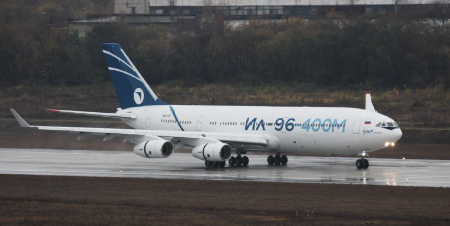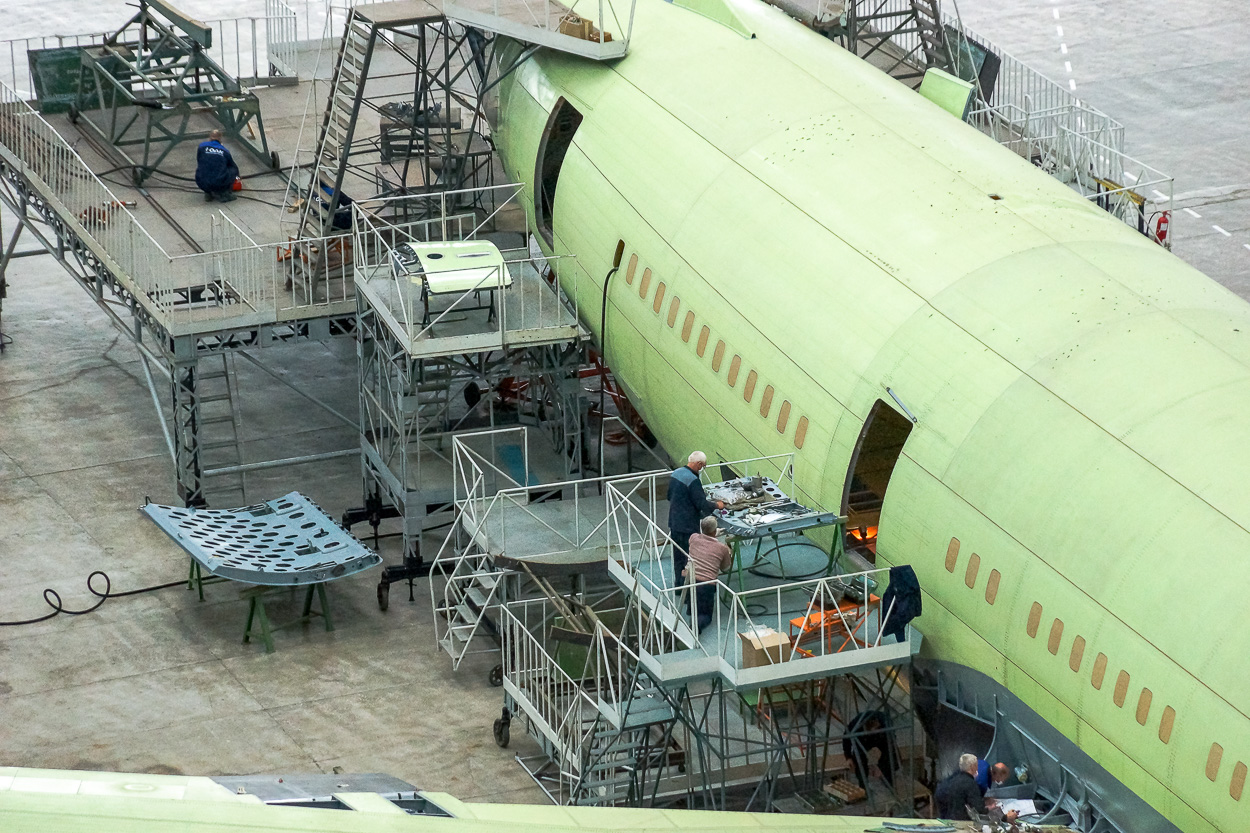https://www.flugrevue.de/zivil/il-96-als-zweistrahler-comeack-fuer-russlands-groessten-airliner/
FROM FOUR-JET TO TWO-JET
This is how Russia imagines the Ilyushin Il-96neo
With four engines, Russia's largest airliner was a flop - the Ilyushin Il-96 always remained a marginal phenomenon. Modernized to a twin-jet aircraft, state-owned company Rostec sees a new opportunity for the Il-96. However, with restrictions.
Patrick Zwerger
October 21, 2023
The latest addition to the small Il-96 family has still not flown - and is still technically outdated. The Ilyushin Il-96-400M , which celebrated its roll-out in Ulyanovsk in July after an almost endless construction period , has (slightly) better engines than the standard version Il-96-300. But there are still four, and not two, as is usual for wide-body airliners today. You may find this anachronism somehow pleasant, but it is not particularly suitable for the future. And we know that in Russia too. At the same time, the fate of the CRAIC CR929 twin jet planned with China is more than unclear after the Russians have withdrawn to the second line in the project and only want to act as a supplier.
Make two out of four
Various representatives from politics and industry in Russia therefore repeatedly speculated about a possible conversion of the Il-96 into a twin-engine aircraft. A suitable engine for such an “Il-96neo” is currently being developed : the Awiadwigatel PD-35 . The fact that the large turbofan is currently not expected to be ready for series production until 2029 at the earliest is not particularly disturbing in this context. After all, the modification to a twinjet on the Il-96 would probably not be possible without time-consuming changes to the design. The wings would probably have to be redesigned accordingly to accommodate the new engines. Theoretically, it would even be conceivable to have wings made of carbon fiber , like those used on the (much smaller) Yakovlev MS-21.
“Not efficient enough”
In a conversation with the Russian daily Izvestia , published on October 12, Rostec General Director Sergei Chemezov once again fueled speculation about a twin-engine Il-96. The issue remains “on the agenda,” emphasized Chemezov. However, there are currently no plans for mass production on a large scale, but rather smaller editions for Russian government aviation and for cargo transport are being considered. The head of Rostec did not say whether this was primarily about building new aircraft or rather about converting used Il-96s. However, Chemezov emphasized to Izvestia that the four-engine Il-96 is "not efficient enough" in long-term operation - not even as a freighter.
Bigger and stronger
The PD-35 engine, designed specifically for the CRAIC CR929, will deliver around 340 kilonewtons of thrust once completed. That would be more than twice what one of the PS-90A engines currently used on the Il-96-300 produces. The PS-90A has a maximum thrust of 160 kN. The further developed version PS-90A1 for the Il-96-400M achieves a little more at 171 kN. With a planned fan diameter of over three meters, the PD-35 would also be significantly larger than the PS-90A, whose fan diameter is only 1.90 meters.
What aerotelegraph is writing about limited production is from this Izvestia article
But it does not make any sense
https://iz.ru/1588513/2023-10-12/glava-rostekha-rasskazal-o-naznachenii-modernizirovannykh-il-96
The head of Rostec spoke about the purpose of the modernized Il-96
Head of Rostec: the project to create modernized Il-96s remains on the agenda
12 October 2023, 18:11
The modernized Il-96 aircraft with two engines are planned to be produced primarily for cargo transportation and the needs of the “Special Flight Detachment “Russia” (SLO). Rostec CEO Sergei Chemezov announced this on October 12.
He noted that the project to create modernized IL-96s with two engines remains on the agenda.
“Most likely, we do not plan to mass produce [the IL-96 with two engines]. They will be produced, as a rule, to order from airlines and special flight squads. In general, most likely, they will be used for transport aircraft, for transporting cargo,” Chemezov said.
According to him, now the Il-96, equipped with PS-90 engines, is not efficient enough for commercial air carriers.
At the same time, he noted that work on the Russian heavy aircraft engine PD-35 continues and software for designing these engines is currently being created. However, Chemezov did not specify the timing of its creation.
My interpretation is that what Sergei Chemezov said was about the existing quadjets il-96-300 and il-96-400M.
The journalists (including those from Izvestia) are quite famous for misinterpreting what is being said and going off on their own conjectures (and often are then quoted by other newspaper or websites).
Russia has absolutely need of a domestic widebody.
When the new twin engine widebody will be ready there will be enough orders.
What will be produced, in the meanwhile, in limited serie (probably not more than 1 or 2 per year) are the existing 4 engine versions of the il-96.
This is at least enough to maintain competences while the new aircraft is developed.
By the way, the new aircraft will not be a il-96 but a twin engine widebody based on the il-96.
The differences will be larger than the differences between the 4 engines Airbus A340 and the 2 engine Airbus A330
The kind of changes needed to move from a 4 engine aircraft to a 2 engine aircraft require a brand new type certificate, not just an update and minor change to it.
It will most probably have a new commercial name.
It could be il-296-X00 but I really doubt it will be il-96-Y00 (by X and y I mean any possible numeral from 1 to 9).
Such new widebody will also have new wings (probably composite wings with the same technology as those of the MC-21 and highly probably a parallel development and very similar to the wings proposed for the CR-929), PD-35 engines, brand new avionics and modern internal systems derived from those of the smaller MC-21 and from those proposed for the CR929.
I can probably imagine also that the cabin will have much more things in common with the MC-21 than with the existing il-96.
This new widebody aircraft will not have anything to envy from the modern Boeing and Airbus widebodies.
The only "old" part of this aircraft will probably be the fuselage, but it is already good enough and a decent mixture of metal alloys and composite (as are the airbus A330 and Boeing 777).



 Rodion_Romanovic
Rodion_Romanovic






